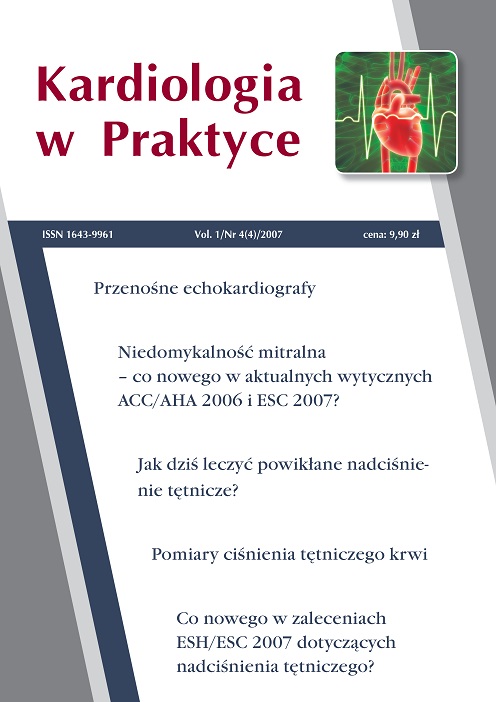Blood pressure measurements Review article
Main Article Content
Abstract
Arterial hypertension is a first cause of worldwide mortality, therefore diagnosis and treatment of hypertension becomes a vital issue. Last ESH/ESC recommendations have not changed classification of arterial hypertension, while endorsed a role of cardiovascular risk assessment during diagnostic approach. Current recommendations permit to consider blood pressure as elevated, though below 140/90 mmHg, if calculated cardiovascular risk is high. Blood pressure measurement has still crucial role in diagnosis of hypertension. Auscultatory or oscillometric methods may be used. Mercury sphygmomanometers and automatic devices might be routinely used.
Downloads
Article Details

This work is licensed under a Creative Commons Attribution-NonCommercial-NoDerivatives 4.0 International License.
Copyright: © Medical Education sp. z o.o. This is an Open Access article distributed under the terms of the Attribution-NonCommercial 4.0 International (CC BY-NC 4.0). License (https://creativecommons.org/licenses/by-nc/4.0/), allowing third parties to copy and redistribute the material in any medium or format and to remix, transform, and build upon the material, provided the original work is properly cited and states its license.
Address reprint requests to: Medical Education, Marcin Kuźma (marcin.kuzma@mededu.pl)
References
2. Roccella E.J., Bowler A.E.: Hypertension as a risk factor. Cardiovasc. Clin. 1990, 20:49-63.
3. Zdrojewski T., Wyrzykowski B., Szczech R. et al.: Steering Committees of the Programmes NATPOL PLUS, SMS, The Polish 400-Cities Project. Blood Press Suppl. 2005, 2:10-16.
4. 2007 Guidelines for the Management of Arterial Hypertension The Task Force for the Management of Arterial Hypertension of the European Society of Hypertension (ESH) and of the European Society of Cardiology (ESC). J. Hypertens. 2007, 25:1105–1187.
5. Lewington S., Clarke R., Qizilbash N. et al. Prospective Studies Collaboration: Age-specific relevance of usual blood pressure to vascular mortality: a meta-analysis of individual data for one million adults in 61 prospective studies. Lancet 2002, 360(9349):1903-1913.
6. O’Brien E., Asmar R., Beilin L. et al. on behalf of the European Society of Hypertension Working Group on Blood Pressure Monitoring: European Society of Hypertension recommendations for conventional, ambulatory and home blood pressure measurement. J. Hypertens. 2003, 21:821-848.
7. Pickering T.G., Hall J.E., Appel L.J. et al.: Recommendations for blood pressure measurement in humans and experimental animals. Hypertension 2005, 45:142-161.
8. Sakuma M., Imai Y., Nagai K. et al.: Reproducibility of home blood pressure measurements over a 1-year period. Am. J. Hypertens. 1997, 10:798- 803.
9. Ohkubo T., Imai Y., Tsuji I. et al.: Home blood pressure measurement has a stronger predictive power for mortality than does screening blood pressure measurement: a population-based observation in Ohasama, Japan. J. Hypertens. 1998, 16:971-975.
10. Fagard R.H., Staessen J.A., Thijs L.: Relationships between changes in left ventricular mass and in clinic and ambulatory blood pressure in response to antihypertensive therapy. J. Hypertens. 1997, 15:1493-1502.
11. Mancia G., Zanchetti A., Agabiti-Rosei E. et al.: Ambulatory blood pressure is superior to clinic blood pressure in predicting treatment induced regression of left ventricular hypertrophy. Circulation, 1997, 95:1464-1470.
12. Fagard R.H., Staessen J.A., Thijs L.: Prediction of cardiac structure and function by repeated clinic and ambulatory blood pressure. Hypertension 1997, 29:22-29.
13. Verdecchia P., Schillaci G., Guerrieri M. et al.: Circadian blood pressure changes and left ventricular hypertrophy in essential hypertension. Circulation, 1990, 81:528-536.
14. Coats A.J.S., Radaelli A., Clark S.J. et al. : The influence of ambulatory blood pressure monitoring on the design and interpretation of trials in hypertension. J. Hypertens. 1992, 10:385-391.
15. Staessen J.A., Thijs L., Fagard R. et al.: Predicting cardiovascular risk using conventional vs ambulatory blood pressure in older patients with systolic hypertension. JAMA 1999, 282:539-546.
16. O’Brien E., Sheridan J., O’Malley K.: Dippers and non-dippers. Lancet 1988, 2:397.
17. Willich S.N., Goldberg R.J., Maclure M. et al.: Increased onset of sudden cardiac death in the first three hours after awakening. Am. J. Cardiol. 1992, 70:65-68.
18. Rocco M.B., Barry J., Campbell S. et al.: Circadian variation of transient myocardial ischemia in patients with coronary artery disease. Circulation 1987, 75:395-400.
19. Muller J.E., Stone P.H., Turi Z.G. et al.: Circadian variation in the frequency of onset of acute myocardial infarction. N. Engl. J. Med. 1985, 313:1315-1322.
20. Elliott W.J.: Circadian variation in the timing of stroke onset: a meta-analysis. Stroke 1998, 29:992-996.
21. Mancia G., Parati G.: Clinical Significance of “White Coat” Hypertension. Hypertension 1990, 16:624-626.
22. Verdecchia P., Schillaci G., Borgioni C. et al.: White coat hypertension and white coat effect. Similarities and differences. Am. J. Hypertens. 1995, 8: 790-798.
23. Mancia G., Facchetti R., Bombelli M. et al.: Long-term risk of mortality associated with selective and combined elevation in office, home, and ambulatory blood pressure. Hypertension 2006, 47:846-853.
24. Palatini P.: Masked hypertension: how can the condition be detected? Blood Press Monit. 2004, 9:297-299.
25. Bobrie G., Chatellier G., Genes N. et al.: Cardiovascular prognosis of “masked hypertension” detected by blood pressure self-measurement in elderly treated hypertensive patients. JAMA 2004, 291:1342-1349.

